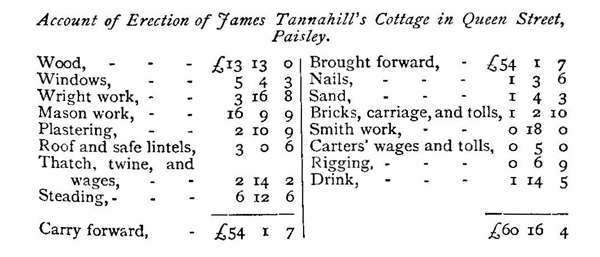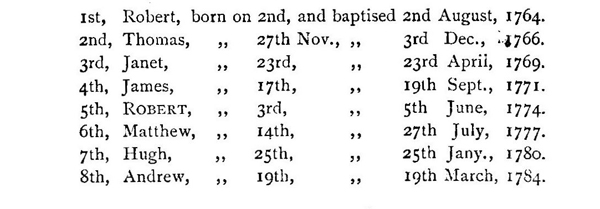Prepared for the 1875 Edition.
Printing was commenced in Paisley in 1769, says our namesake, William Semple, the historian of the town, by Messrs. Alexander Weir, bookseller, and Andrew M`Lean, printer. They were burgesses of Paisley—the former in 1758, and the latter in 1771. These printers, and Mr. John Neilson, who commenced business shortly thereafter, printed numerous works of different authors by subscription, which, being circulated among the inhabitants of the town, increased the intelligence of the inhabitants of Paisley. These books generally contained a list of the subscribers' names, and it is very interesting at the present time to read the names of our forefathers recorded and preserved in these printed volumes. About 1770, and for thirty years afterwards, a number of book clubs were instituted in Paisley for mental culture. One club purchased one class of books for circulation among its members, and another club procured another class of books for their members. These several clubs again accommodated each other, and interchanged books until every member had an opportunity of perusing the whole books in the several clubs. The most important of the book clubs was the Encyclopedia Club, which took out the first edition of the work of that name in 3 vols., quarto, published in 1771; the second edition of 10 vols., in 1778 and 1783; and the third edition of 18 vols., in 1797.
In 1775, James Tannahill acquired Bailie Slater's steading in Queen Street, and erected upon it a one-storey thatched cottage, with a passage through the centre—the north side being occupied as a dwelling-house, and the south side as a four-loom weaving-shop. James Tannahill was a very accurate individual, and he kept an account of the whole cost of the building, which has been preserved in his memorandum or note pocket-book to the present day. The book was originally rather tastefully got up, and this precious relic of the Tannahills is still in existence,—carefully preserved by one of the daughters of James Tannahill, the immediate elder brother of the Poet. The handwriting of the father is even better than that of any of his sons. The building of the house was one of the important acts in the life of James Tannahill, and to show the cost of a house of a bein weaver in Paisley a hundred years ago, we give it here:—

Only the last item in the account requires explanation. In these days, and for centuries previous, it was the practice to give the masons “founding and finishing pints,” and a drink every morning of a certain beverage during the progress of the work. The amount of these, it would appear, came to £1 14s. 5d. There is also another entry in the memorandum note-book, “5th June, 1776, Widow Dunn, dinner and drink, £2 14s. 6d,” which we believe was the sum expended in the “house heating”—the entertainment given to friends on entering upon the occupancy of a newly finished house. At that entertainment, we believe the three Bailies of the town were present.
James Tannahill was about five feet four inches in height, and of slender make. He was of a gentle disposition, with a considerable amount of pride. Mrs. Tannahill was nearly the same height as her husband. She had a hale constitution, was a strong-minded woman, and well able to manage the affairs of her household. The couple generally appeared in public on Saturday afternoons to take a walk, as was the custom in those days, the gudeman dressed in blue coat with dollar buttons, silk vest, knee breeches with silver buckles, linen thread stockings, and silver buckles in his shoes; and his wife in white linen cap, or mutch, and scarlet cloak. They had eight children, seven sons and one daughter, born and baptised, as recorded in the Register of Baptisms for the Burgh of Paisley, as follows:—

As the entries of the births in the handwriting of the father in the memorandum book may be considered interesting, we insert them, as follows:—
The eldest child, named Robert in the Register, is called Thomas in the private memorandum book of the father, and died in infancy at thirteen months; Thomas, the second son, would be named after his paternal grandfather, Thomas Tannahill; Janet, the daughter, after her maternal grandmother, Janet Brodie; James, the third son, after his father; Robert, the fourth son, after his paternal uncle, Robert Tannahill; Matthew, after his maternal grandfather, Matthew Pollock ; Hugh, after his maternal granduncle, Hugh Brodie ; and Andrew, after Elizabeth Brodie's father, Andrew Brodie.
Bailie Slater died before James Tannahill obtained his Feu Disposition, and the granting of it had to be delayed till his only child, Janet Slater, was served heiress to her father.
On 25th May, 1779, the Bailies and Town Council of Paisley, with consent of Janet Slater, spouse of Robert Orr, manufacturer, Paisley, executed the Feu Disposition to James Tannahill, weaver in Paisley, of “All and Haill, that steading of ground in Broomlands of Paisley, with the house built by him thereon, and yard at the back of the same ; bounded by Alexander Gibson's house and yard on the south; a corner steading, sold to Thomas Whyte, on the north; the highway on the west; and Walter Macfarlane's yard on the east parts.” James Tannahill and his wife were strongly attached to the cottage belonging to, and erected by themselves. All the children were brought up in that dwelling and their earliest associations were connected with their sweet home, where their happiest days were spent.
The Hospital, in New Sneddon Street, was managed by 15 Directors,—three from the Town Council, three from the Kirk Session, and nine chosen from the town at large. On 1st June, 1786, Mr. James Tannahill was chosen one of these nine Directors of the Hospital, and he was re-elected annually for five successive years. In several of these years he stood at the head of those chosen from the community, which showed the esteem in which he was held by his fellow-townsmen. During his term of office the bell was put into the belfrey of the Hospital, and three times a day called the inmates to their meals. Those acquainted with hell language interpreted its voice to ring:
“Tinklum, tanklum, tinklum, tanklum,
Tak' your parritch, or want them !”
Porridge in these days was the chief article of food for breakfast and supper. The bell settled all complaints about the food; and those inmates who would not take the diet at one meal, could take it at the next. James Andrew, schoolmaster, an acquaintance of James Tannahill, carefully educated the children in the Hospital, and took charge of the Minute Book of the Hospital. The names of James Tannahill and James Andrew will be found as subscribers to books published about this period.